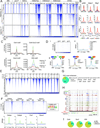Cooperative Binding of Transcription Factors Orchestrates Reprogramming
- PMID: 28111071
- PMCID: PMC5302508
- DOI: 10.1016/j.cell.2016.12.016
Cooperative Binding of Transcription Factors Orchestrates Reprogramming
Abstract
Oct4, Sox2, Klf4, and cMyc (OSKM) reprogram somatic cells to pluripotency. To gain a mechanistic understanding of their function, we mapped OSKM-binding, stage-specific transcription factors (TFs), and chromatin states in discrete reprogramming stages and performed loss- and gain-of-function experiments. We found that OSK predominantly bind active somatic enhancers early in reprogramming and immediately initiate their inactivation genome-wide by inducing the redistribution of somatic TFs away from somatic enhancers to sites elsewhere engaged by OSK, recruiting Hdac1, and repressing the somatic TF Fra1. Pluripotency enhancer selection is a stepwise process that also begins early in reprogramming through collaborative binding of OSK at sites with high OSK-motif density. Most pluripotency enhancers are selected later in the process and require OS and other pluripotency TFs. Somatic and pluripotency TFs modulate reprogramming efficiency when overexpressed by altering OSK targeting, somatic-enhancer inactivation, and pluripotency enhancer selection. Together, our data indicate that collaborative interactions among OSK and with stage-specific TFs direct both somatic-enhancer inactivation and pluripotency-enhancer selection to drive reprogramming.
Keywords: Klf4; Oct4; Sox2; collaborative binding; enhancers; induced pluripotent stem cells; pluripotency; reprogramming; transcription factors.
Copyright © 2017 Elsevier Inc. All rights reserved.
Figures







References
-
- Bar-Joseph Z, Gifford DK, Jaakkola TS. Fast optimal leaf ordering for hierarchical clustering. Bioinformatics. 2001;17(Suppl 1):S22–S29. - PubMed
-
- Beard C, Hochedlinger K, Plath K, Wutz A, Jaenisch R. Efficient method to generate single-copy transgenic mice by site-specific integration in embryonic stem cells. Genesis. 2006;44:23–28. - PubMed
MeSH terms
Substances
Grants and funding
LinkOut - more resources
Full Text Sources
Other Literature Sources
Molecular Biology Databases
Research Materials
Miscellaneous

